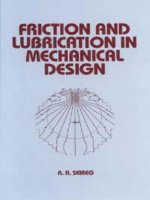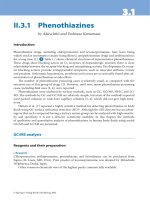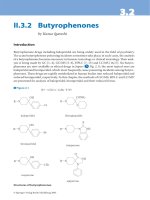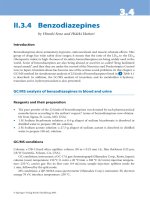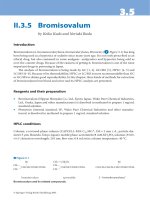Tài liệu Progress and Trends in Ink-jet Printing Technology ppt
Bạn đang xem bản rút gọn của tài liệu. Xem và tải ngay bản đầy đủ của tài liệu tại đây (1.09 MB, 31 trang )
Progress and Trends in Ink-jet
Printing Technology
Part 1
Hue P. Le*
Le Technologies, Inc., Beaverton, Oregon
This paper provides a brief review of the various paths undertaken in
the development of ink-jet printing. Highlights of recent progress and
trends in this technology are discussed. The technologies embedded in
the latest ink-jet products from current industry leaders in both thermal
and piezoelectric drop-on-demand ink-jet methods are also described.
Finally, this article presents a list of the potential ink-jet technology
applications that have emerged in the past few years.
Journal of Imaging Science and Technology 42: 49–62 (1998)
Original manuscript received November 3, 1997
* IS&T Member
(E-mail: )
© 1998, IS&TThe Society for Imaging Science and Technology
Ink-jet Printing Development Path
Ink-jet is a non-impact dot-matrix printing technology in which droplets
of ink are jetted from a small aperture directly to a specified position on
a media to create an image. The mechanism by which a liquid stream
breaks up into droplets was described
1
by Lord Rayleigh in 1878. In
1951, Elmqvist of Seimens patented the first practical Rayleigh break-
up ink-jet device.
2
This invention led to the introduction of the
Mingograph, one of the first commercial ink-jet chart recorders for
analog voltage signals. In the early 1960s, Dr. Sweet of Stanford
University demonstrated that by applying a pressure wave pattern to an
orifice, the ink stream could be broken into droplets of uniform size and
spacing.
3
When the drop break-off mechanism was controlled, an
electric charge could be impressed on the drops selectively and reliably
as they formed out of the continuous ink stream. The charged drops
when passing through the electric field were deflected into a gutter for
recirculation, and those uncharged drops could fly directly onto the
media to form an image.
4
This printing process is known as a
continuous ink-jet. By the late 1960s, Sweet's inventions led to the
introductions of A. B. Dick VideoJet and the Mead DIJIT products. In the
1970s, IBM licensed the technology and launched a massive
development program to adapt continuous ink-jet technology for their
computer printers. The IBM 4640 ink-jet printer was introduced in 1976
as a word processing hardcopy-output peripheral application.
5
At approximately the same time, Professor Hertz of the Lund Institute of
Technology in Sweden and his associates independently developed
several continuous ink-jet techniques that had the ability to modulate
the ink-flow characteristics for gray-scale ink-jet printing. One of
Professor Hertz's methods of obtaining gray-scale printing was to
control the number of drops deposited in each pixel.
6
By varying the
number of drops laid down, the amount of ink volume in each pixel was
controlled, therefore the density in each color was adjusted to create
the gray tone desired. This method was licensed to companies such as
Iris Graphics and Stork to produce commercial high-quality color
images for the computer prepress color hardcopy market.
7
While continuous ink-jet development was intense, the development of
a drop-on-demand ink-jet method was also popularized. A drop-on-
demand device ejects ink droplets only when they are used in imaging
on the media. This approach eliminates the complexity of drop charging
and deflection hardware as well as the inherent unreliability of the ink
recirculation systems required for the continuous ink-jet technology.
Zoltan
8
and Kyser and Sears
9
are among the pioneer inventors of the
drop-on-demand ink-jet systems. Their inventions were used in the
Seimens PT-80 serial character printer (1977) and by Silonics (1978). In
these printers, on the application of voltage pulses, ink drops are
ejected by a pressure wave created by the mechanical motion of the
piezoelectric ceramic.
Many of the drop-on-demand ink-jet ideas and systems were invented,
developed, and produced commercially in the 1970s and 1980s. The
simplicity of the drop-on-demand ink-jet system was supposed to make
ink-jet technology more reliable. However, during this period, the
reliability of ink-jet technology remained poor. Problems such as nozzle
clogging and inconsistency in image quality plagued the technology.
In 1979, Endo and Hara of Canon invented a drop-on-demand ink-jet
method where ink drops were ejected from the nozzle by the growth
and collapse of a water vapor bubble on the top surface of a small
heater located near the nozzle.
10
Canon called the technology the
bubble jet. The simple design of a bubble jet printhead along with its
semiconductor compatible fabrication process allowed printheads to be
built at low cost and with high nozzle packing density. Apparently,
during the same time period or shortly thereafter, Hewlett-Packard
independently developed a similar ink-jet technology.
11
In 1984, Hewlett-Packard commercialized the ThinkJet printer. It was
the first successful low-cost ink-jet printer based on the bubble jet
principle. Hewlett-Packard named the technology thermal ink-jet. The
cost of a ThinkJet printhead consisting of 12 nozzles was low enough
that the printhead could be replaced every time the ink cartridge was
empty. Hewlett-Packard's concept of a disposable ink-jet printhead was
brilliant and original. They solved the reliability problem of ink-jet
technology by throwing away the printhead at the end of its useful life.
Since then, Hewlett-Packard and Canon have continuously improved
on the technology. Their efforts were rewarded with a series of
successful product introductions. Ink-jet printer models with higher
printing resolution and color capability were made available with very
affordable prices. Since the late 1980s, because of their low cost, small
size, quietness, and particularly their color capability, the thermal ink-jet
or bubble jet printers became the viable alternative to impact dot-matrix
printers for home users and small businesses. Currently, thermal ink-jet
printers dominate the low-end color printer market.
Throughout the course of ink-jet development, ink chemists and media
engineers realized that when a liquid ink droplet contacts the surface of
paper, it tends to spread along paper fiber lines as well as penetrate
into paper sizing and voids. The spreading of ink droplets is often too
excessive and too irregular to maintain the resolution required. The
penetration of ink into the paper is often too slow to absorb multiple ink
drops on the same spot within very short time intervals. The poor color
image quality due to ink spreading and intercolor bleeding is recognized
as the critical issue in the development of ink-jet technology.
To obtain a high-quality color ink-jet image, the surface of the media
requires a special coating. The special ink-jet-coated media must
balance between many design parameters such as drop volume,
evaporation rate, penetration rate, coating thickness, porosity, etc.
Development activi ties in ink-jet media were started in the early 1980s,
predominantly in Japan with paper companies such as Jujo Paper and
Mitsubishi Paper Mills leading the industry. Today, because of the
popularity of color ink-jet printers, the market demand for better media
such as ink-jet glossy and photomedia is more significant. This has
attracted a number of companies to ink-jet-media development. Canon,
Xerox, Asahi Glass, Arkwright, Folex, 3M and Imation are among the
many companies currently active in this field.
Another approach to obtaining better image quality without relying on
special media is the use of solid ink (or hot melt or phase-change ink).
In operation, the ink is jetting as molten liquid drops. On contact with
the media, the ink material solidifies, very little spreading and
absorption occurs so that brilliant color and high resolution can be
realized almost independent of the substrate properties. The early
development of solid ink was initiated at Teletype for electrostatic ink-jet
devices.
12
The later application to drop-on-demand devices occurred at
Exxon
13
and Howtek.
14
Today, Tektronix, Dataproducts, Spectra, and
Brother are among active companies pursuing solid ink-jet technology.
For more details of the ink-jet printing development paths, there are at
least four excellent reviews of ink-jet printing in the past literature.
Progress and Trends in Ink-jet
Printing Technology
Part 2
Hue P. Le*
Le Technologies, Inc., Beaverton, Oregon
Technology Map
Ink-jet printing has been implemented in many different designs and
has a wide range of potential applications. A basic map of the ink-jet
technologies is shown in Fig. 1. Fundamentally, ink-jet printing is
divided into the continuous and the drop-on-demand ink-jet methods.
Figure 1. Ink-jet technologies map.
Depending on the drop deflection methodology, the continuous ink-jet
can be designed as a binary or multiple deflection system. In a binary
deflection system, the drops are either charged or uncharged. The
charged drops are allowed to fly directly onto the media, while the
uncharged drops are deflected into a gutter for recirculation (Fig. 2). In
a multiple deflection system, drops are charged and deflected to the
media at different levels (Fig. 3). The uncharged drops fly straight to a
gutter to be recirculated. This approach allows a single nozzle to print a
small image swath. Both of these methods are widely used in the
industrial coding, marking, and labeling markets. Companies such as
VedioJet, Domino, Imaje, Toxot, and Willet are actively developing and
marketing products in this area. Recently, Nur Advanced Technologies
demonstrated an up to 16.4 ft billboard size ink-jet printer using
continuous ink-jet technology. In addition to the above two methods,
Hertz's continuous ink-jet process can be classified as a separate
method. This method's success in the market is because of its unique
way of obtaining the gray scale through a burst of small drops. Hertz'
concept is used in products such as Iris's Realistic for the graphic arts
market and Scitex's digital Press for the high-speed on-demand printing
market.
Figure 2. Continuous ink-jet: A binary-deflection system.
Figure 3. Continuous ink-jet: A multiple-deflection system.
The majority of activity in ink-jet printing today is in the drop-on-demand
methods. Depending on the mechanism used in the drop formation
process, the technology can be categorized into four major methods:
thermal, piezoelectric, electrostatic, and acoustic ink-jet. Most, if not all,
of the drop-on-demand ink-jet printers on the market today are using
either the thermal or piezoelectric principle. Both the electrostatic ink-
jet
19–22
and acoustic ink-jet
23,24
methods are still in the development
stage with many patents pending and few commercial products
available.
The thermal ink-jet method was not the first ink-jet method implemented
in a product, but it is the most successful method on the market today.
Depending on its configuration, a thermal ink-jet can be a roof-shooter
(Fig. 4) with an orifice located on top of the heater, or a side-shooter
(Fig. 5) with an orifice on a side located nearby the heater. The roof-
shooter design is used in the printheads from Hewlett-Packard,
Lexmark, and Olivetti. The side-shooter design is implemented in the
Canon and Xerox printheads.
Figure 4. A roof-shooter thermal ink-jet.
Figure 5. A side-shooter thermal ink-jet.
In the piezoelectric ink-jet, depending on the piezoceramic deformation
mode (Fig. 6), the technology can be classified into four main types:
squeeze, bend, push, and shear.
Figure 6. Basic deformation modes of a piezoceramic plate.
A squeeze-mode ink-jet can be designed with a thin tube of
piezoceramic surrounding a glass nozzle as in a Gould's impulse ink-
jet
25
or with a piezoceramic tube cast in plastic that encloses the ink
channel as was implemented in a Seimens PT-80 ink-jet printer.
7
The
Seimens PT-80 printer was introduced in 1977. With a printhead array
of twelve jets and an innovative maintenance station design, this
product was fast and reliable enough to be the first truly successful ink-
jet product for the office. Subsequent efforts by the company to
introduce a second-generation printhead with a 32-jet array
encountered difficulty in achieving jet-to-jet uniformity.
In a typical bend-mode design (Fig. 7), the piezoceramic plates are
bonded to the diaphragm forming an array of bilaminar
electromechanical transducers used to eject the ink droplets. The
printheads in Tektronix's Phaser 300 and 350 and Epson's Color Stylus
400, 600, and 800 ink-jet printers are based on this design principle.
In a push-mode design (Fig. 8), as the piezoceramic rods expand, they
push against ink to eject the droplets. In theory, piezodrivers can
directly contact and push against the ink. However, in practical
implementation, a thin dia phragm between piezodrivers and ink is
incorporated to prevent the undesirable interactions between ink and
piezodriver materials. Successful implementation of the push-mode
piezoelectric ink-jet is found in the printheads from companies such as
Dataproducts, Trident, and Epson.
In both the bend- and push-mode designs, the electric field generated
between the electrodes is in parallel with the polarization of the
piezomaterial. In a shear-mode printhead, the electric field is designed
to be perpendicular to the polarization of the piezodriver (Fig. 9). The
shear action deforms the piezoplates against ink to eject the droplets.
In this case, the piezodriver becomes an active wall in the ink chamber.
Interaction between ink and piezomaterial is one of the key parameters
of a shear-mode printhead design. Companies such as Spectra
26
and
Xaar
27,28
are pioneers in the shear-mode printhead design.
Figure 7. A bend-mode piezoelectric ink-jet design.
Figure 8. A push-mode piezoelectric ink-jet design.
Figure 9. A shear-mode piezoelectric ink-jet design.
Figure 10. Drop formation process of a thermal ink-jet.
Progress and Trends in Ink-jet
Printing Technology
Part 3
Hue P. Le*
Le Technologies, Inc., Beaverton, Oregon
Recent Developments and Trends in
Technology
Printhead Design and Fabrication Processes. Today the ink-jet
technologies most active in laboratories and in the market are the
thermal and piezoelectric drop-on-demand ink-jet methods. In a basic
configuration, a thermal ink-jet consists of an ink chamber having a
heater with a nozzle nearby. With a current pulse of less than a few
microseconds through the heater, heat is transferred from the surface
of the heater to the ink. The ink becomes superheated to the critical
temperature for bubble nucleation, for water-based ink, this
temperature is
29
around 300°C. When the nucleation occurs, a water
vapor bubble instantaneously expand to force the ink out of the nozzle.
Once all the heat stored in the ink is used, the bubble begins to
collapse on the surface of the heater. Concurrently with the bubble
collapse, the ink droplet breaks off and excels toward the paper. The
whole process of bubble formation and collapse takes place in less
than 10 µs. The ink then refills back into the chamber and the process
is ready to begin again. Depending on the channel geometry and ink's
physical properties, the ink refill time can be from 80 to 200 µs. This
process is illustrated in Fig. 10. Figure 11 reillustrates the same process
by plotting the parameters including electrical pulse, temperature,
pressure, and bubble volume against time.
Figure 11. Pressure, temperature, and bubble volume changes during
a drop formation cycle of thermal ink-jet.
Figure 12. A SEM photograph of a channel in the Hewlett-Packard
DeskJet 850C color printhead.
Figure 12 shows a scanning electron microscope (SEM) photograph of
a Hewlett-Packard 800 series thermal ink-jet channel with heater and
ink barrier layer (the aper ture plate was removed). This jet was known
to produce 32 pl ink droplets at the rate of 6000 drops per second. The
ink channel in the SEM photograph is measured at about 0.001 of an
inch in thickness and little more in width. However, the dimensional
stability, accuracy, and uniformity of this channel are known to have
great effects on jet performance such as drop frequency, volume, and
velocity. All of these drop performances ultimately determine the quality
and throughput of a printed image. The trends in the industry are in
jetting smaller droplets for image quality, faster drop frequency, and a
higher number of nozzles for print speed, while the cost of manufacture
is
Figure 13. A light microscopic photograph of a channel in the Hewlett-
Packard DeskJet 890C color printhead.
Figure 14. The basic configuration of a piezoelectric printhead.
Figure 15. The basic pressure requirement for ejecting an ink droplet.
reduced. These trends force further miniaturization of the ink-jet design.
Consequently, the reliability issue becomes critical. In the latest
generation of the Hewlett-Packard 800 series, the company introduced
a new 192-nozzle tricolor printhead that can jet much smaller ink
droplets (10 pl) at the rate of 12,000 drops per second. Figure 13 is a
light microscopic photograph of an ink-jet channel from a Hewlett-
Packard new tricolor printhead for the DeskJet 890C. The channel
heater is measured about one mil square. Ink feeds from both sides of
the heater chamber. This fluid architecture would significantly decrease
the possibility of nozzle clogging that may result from particulates
trapped in the printhead fabrication processes as well as in the process
of making inks. A row of small openings between the ink manifold and
the heater chamber was also introduced in the new design, in order to
improve the reliability of the new printhead.
Another trend in the industry is market demand for lower cost per print.
Printhead producers could pack in greater ink volume per cartridge to
increase the print count or install a permanent or semipermanent
thermal printhead to reduce the cost of new ink cartridges. Again, this
trend will demand even higher reliability for thermal ink-jet printheads.
Canon is another major company that develops and produces thermal
ink-jet printers. In the latest bubble-jet product BJC-7000, Canon
introduced a 480-nozzle printhead. By far, this is the highest nozzle
count for a single printhead module marketed to the home and small
office color ink-jet printer market. In the BJC-7000 implementation, the
480-nozzle printhead consists of six colors with 80 nozzles per color.
Other companies that develop and manufacture thermal ink-jet
printheads are Lexmark, Olivetti, and Xerox.
In the piezoelectric drop-on-demand ink-jet method (Fig. 14),
deformation of the piezoceramic material causes the ink volume
change in the pressure chamber to generate a pressure wave that
propagates toward the nozzle. This acoustic pressure wave overcomes
the viscous pressure loss in a small nozzle and the surface tension
force from ink meniscus so that an ink drop can begin to form at the
nozzle. When the drop is formed, the pressure must be sufficient to
expel the droplet toward a recording media. The basic pressure
requirement is showed in Fig. 15.
Table I. A Current List of the Piezoelectric Drop-On-Demand Ink-Jet Printhead Producers
Producer Piezo Deformation Printer Example
Tektronix Bend-mode Tektronix Phaser 350 & 380
Sharp Bend-mode Mutoh RJ-1300 & RJ-1800
Epson Bend-mode Epson Color Stylus 400, 600, and 800
Dataproducts Push mode Idanit 162Ad
Spectra Shear mode Polaroid DryJet, 3D Actua 2100
Nu-Kote Shear mode Raster Graphics PiezoPrint 5000
Topaz Technologies Bend/ Calcomp shear combination CrystalJet
Figure 16. Cross section SEM photographs of a Tektronix stainless
steel jet stack.
Figure 17. Cross section SEM photographs of a bond line in a Sharp
stainless steel jet pack.
Figure 18. A cross section SEM photograph of a Spectra printhead.
In general, the deformation of a piezoelectric driver is on the submicron
scale. To have large enough ink volume displacement for drop
formation, the physical size of a piezoelectric driver is often much larger
than the ink orifice. Therefore, miniaturization of the piezoelectric ink-jet
printhead has been a challenging issue for many years. A list of
piezoelectric drop-on-demand printhead producers is provided in Table
I.
Tektronix (352 nozzle) and Sharp (48 nozzle) printheads are made with
all stainless steel jet stacks. These jet stacks consist of multiple
photochemical machined stainless steel plates bonded or brazed
together at a high temperature. Figure 16 shows a cross section SEM
photograph of a Tektronix jet stack. The thin Au intermetallic bonding
layers are visible between the brazed plates. The intermetallic bond in
ink-jet printhead application requires uniform thickness for design
performance consistency and hermetic sealing to prevent inks from
leaking externally or between two adjacent ink channels. Similar
bonding characteristics are found in a Sharp jet stack. Figure 17 shows
a cross section SEM photograph of the Ni intermetallic bond between
the stainless steel plates of the Sharp printhead.
Besides using Au or Ni to bond metal plates together, solder and epoxy
are also used to fabricate printheads. Figure 18 shows a cross section
SEM photograph of a Spectra printhead where the electroformed nickel
orifice plate is bonded to the jet stack by epoxy. In the same
photograph, the solder bonds between multiple steel plates are also
noticed. However, due to ink compatibility issues, the selection of epoxy
or solder composition must be carefully considered. Given the trends to
increasing the number of nozzles, decreasing their physical size, and
jetting many different fluids, bond integrity and stability of the printhead
become increasingly critical issue.
In 1993, Epson introduced the Stylus 800 piezoelectric ink-jet printer to
compete directly with thermal ink-jet or bubble-jet technology in the low-
end home and small office printer market. This product introduction was
very significant in the sense that it was the first time a reliable low-cost
piezoelectric ink-jet with a permanent printhead was successfully
introduced in a low-end printer. This Epson printhead is based on a
push-mode design with a multilayer piezoactuator.
30
Based on the same
printhead technology, Epson introduced Stylus Color in 1994 and Color
Stylus II in 1995. A cross section SEM photograph of an Epson push-
mode jet is shown in Fig. 19. Figure 20 shows a SEM photograph of a
multilayer PZT actuator with 20 µm thickness per layer. Alternate
electrodes are seen in both sides of each PZT layer. With this design,
Epson fabricated a 64-nozzle printhead with a nozzle-to-nozzle spacing
of 140 µm to achieve a nozzle density of 180 dpi.
In 1997, Epson introduced Color Stylus 400, 600, and 800 with a bend-
mode design piezoelectric printhead. Color Stylus 800 employs two
printheads: 128-nozzle for black and 192-nozzle for color (CMY). The
technological breakthrough in this new bend-mode piezo printhead
introduction is in the unique fabrication method for the thick film PZT
sintered on top of the zirconia diaphragm to make piezoelectric drivers.
A SEM photograph of the PZT/diaphragm drivers is shown in Fig. 21.
These PZT/diaphragm structures measure less than 1 mils in total
thickness. In contrast to the PZT/diaphragm structures in a Tektronix
bend-mode printhead, PZT thickness is about 6 mils and stainless steel
diaphragm thickness is about 3 mils. Significant reduction in the
thickness of driver structures allows Epson to miniaturize the 192-
nozzle printhead to about 18 ¥ 34.8 mm with a nozzle density of 180
dpi. Note that, as compared to the push mode with a long PZT structure
design, the new Epson thick film PZT bend-mode device has a planar
structure. The fabrication process for the new design is simple and less
costly. Furthermore, with a small, flat and thin printhead structure, any
addition of heaters to control the operating temperature of the printhead
is much easier to design. The trends here are to increase the number of
nozzles and add more flexibility in ink formulations, as was potentially
realized with Epson's new printhead technology.
Figure 19. A cross section SEM photograph of an Epson Stylus 800
printhead.
Figure 20. A SEM photograph of a multilayer piezoceramic driver in the
Epson Stylus 800 printhead.
Figure 21. A SEM photograph of the thick film PZT on the zirconia
diaphragm in the Epson Color Stylus 800 printhead.
Nu-Kote 128-nozzle and Topaz Technologies 256-nozzle piezoelectric
drop-on-demand printheads are the two newest additions to the ink-jet
market. The Nu-Kote printhead is based on the development of a Xaar
shear-mode shared wall design.
31
Raster Graphics uses three 128-
nozzle printheads per color in their newly introduced PiezoPrint 5000
large-format color ink-jet printer. The technology is about 10 years old,
but the field experience is new. A key challenge for the Nu-Kote
printhead is its reliability in the market.
The Topaz 256-nozzle printhead is also new to the industry. It is known
to combine both the bend and shear modes to jet ink droplets at a
relatively high-drop-ejection frequency. The technology was introduced
in the Calcomp CrystalJet large-format ink-jet printer. Thus far, no
product has been shipped yet.
Independently from the thermal or piezo ink-jet method, bend or shear
mode, one of the most critical components in a printhead design is its
nozzle. Nozzle geometry such as diameter and thickness directly
effects drop volume, velocity, and trajectory angle. Variations in the
manufacturing process of a nozzle plate can significantly reduce the
resulting print quality. Image banding is a common result from an out-of-
specification nozzle plate. Various nozzle geometries designed for the
ink-jet printheads are summarized in Fig. 22. The two most widely used
methods for making the orifice plates are electroformed nickel (Fig. 23)
and laser ablation on the polyimide (Fig. 24). Other known methods for
making ink-jet nozzles are electro-discharged machining (Fig. 25),
micropunching, and micropressing.
Because smaller ink drop volume is required to achieve higher
resolution printing, the nozzle diameter of printheads has become
increasingly small. For jetting an ink droplet of 14 pl, Epson Color
Stylus 800 printhead has nozzle diameter of less than 30 µm. For 10 pL
droplets, Hewlett-Packard DeskJet 890C color printhead has nozzle
diameter of around 20 µm. With the trends towards smaller diameters
and lower cost, the laser ablation method has become popular for
making ink-jet nozzles.
Figure 22. Various types of ink-jet printhead nozzle designs
Figure 23. A SEM photograph from the entrance side of an
electroformed Ni nozzle.
Figure 24. SEM photographs from the entrance side of a laser ablation
polyimide nozzle plate.
Figure 25. A SEM photograph of an EDM stainless steel nozzle
Progress and Trends in Ink-jet
Printing Technology
Part 4
Hue P. Le*
Le Technologies, Inc., Beaverton, Oregon
Ink Chemistry. The most critical component of ink-jet printing is
probably the ink. Ink chemistry and formulations not only dictate the
quality of the printed image, but they also determine the drop ejection
characteristics and the reliability of the printing system. Many different
types of inks have been developed and used in ink-jet applications.
Figure 26 illustrates a technology map of different types of ink-jet inks.
Aqueous- or water-based inks are commonly used in home and small-
office ink-jet printers such as in the Hewlett-Packard DeskJet series,
Canon BJC series, and Epson Color Stylus series ink-jet printers. In the
case of thermal ink-jet, due to the basic vapor bubble formation
process, water seems the material of choice for the method. Typical
composition of a water-based ink for ink-jet printing is presented in
Table II. Viscosity of water-based ink-jet inks range from 2 to 8 cps.
Figure 27 illustrates the behavior of a water-based ink droplet when it
lands on the surface of an uncoated media such as bond, copy, or plain
papers. The ink tends to spread along the paper fibers and penetrate
into the bulk of the paper. The water-based ink actually depends on
penetration and absorption for its drying mechanism. Some evaporation
of water is taking place, but this drying mechanism is often very slow.
Such ink behavior lowers color density and spot resolution on paper. It
has been known for some time that paper or other media with a coated
water-receiving layer can greatly improve both color density and
resolution by controlling the ink spreading and penetration at the coated
layer. However, just within the past few years, the market for the
specialty-coated ink-jet media has exploded, especially in the home
photo quality and large-format ink-jet printing areas.
32
Recent
availability of printhead technologies with high resolution (such as 1440
dpi Epson Color Stylus 800, 1200 x 1200 dpi Lexmark 7000, 10 pL drop
Hewlett-Packard DeskJet 890C), multilevel dye load gray-scale (such
as in photo pens from Epson, Canon, and Hewlett-Packard), and
multilevel dot volume gray-scale capability (such as in Hewlett-Packard
DeskJet 720C and 890C) certainly have made a positive impact on this
trend.
Figure 26. An ink-jet ink technologies map.
Table II. Water-Based Ink-Jet Ink Composition
Component Function Concentration, %
Deionized water
Aqueous carrier medium
60 - 90
Water soluble solvent Humectant, viscosity control 5 - 30
Dye or pigment Provides color 1 - 10
Surfactant Wetting, penetrating 0.1 - 10
Biocide Prevents biological growth 0.05 - 1
Buffer Controls the pH of ink 0.1 - 0.5
Other additives Chelating agent, defoamer, solublizer etc. > 1
Figure 27. Drying mechanisms of a water-based ink-jet drop on a plain
paper.
Figure 28. A SEM photograph of phase-change ink drops on the
surface of a bond paper.
Figure 29. A SEM photograph of phase-change ink drops after fuse by
cold pressure rollers.
Figure 30. The basic configuration of the Tektronix's Phaser 350 offset
drum transfer ink-jet printer.
Figure 31. A SEM photograph of a phase-change ink drop on the
surface of aluminum substrate.
Phase-change ink is also called hot melt or solid ink which is solid at
room temperature. The ink is jetted out from the printhead as a molten
liquid. Upon hitting a recording surface, the molten ink drop solidifies
immediately, thus preventing the ink from spreading or penetrating the
printed media. The quick solidification feature ensures that image
quality is good on a wide variety of recording media. Figure 28 shows a
SEM photograph of phase-change ink drops printed on the surface of a
Xerox 4024 bond paper. Notice that the ink drops maintain their
hemisphere shape with little or no evidence of ink spreading, even
along rough paper fiber structures. Tektronix currently implements
phase-change ink-jet technology in the Phaser 300 ink-jet printer.
However, in practice, the solidified ink drops need to be fused on top of
paper to increase ink adhesion and prevent light scattering owing to the
lens effect of the hemisphere shaped ink dot.
33
Figure 29 shows a SEM
photograph of several Tektronix Phaser 300 phase-change ink drops
after being fused by a cold pressure fusing roller.


